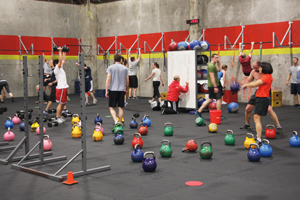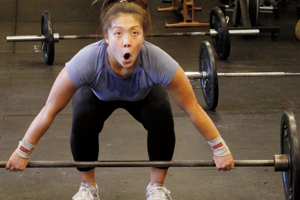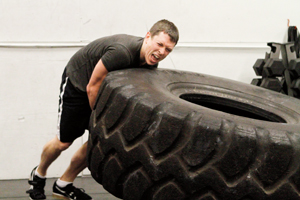CrossFit Gyms

Offering that ‘holy grail’ of a fast, efficient workout
By Rebecca Agiewich
At Right: No fancy machinery required at CrossFit gyms. Photo courtesy of Level 4 CrossFit Seattle.
The Level 4 CrossFit Seattle doesn’t look like your typical gym. In the sprawling warehouse-style space in Seattle’s Ballard neighborhood, no loud music assaults your ears. There are no elliptical trainers, treadmills, or Nautilus machines.
The few people working out here on a mid-morning Wednesday don’t wear headphones while staring vacantly at competing televisions. Instead, they’re actively engaging with one or two other people doing various exercises—some familiar-looking (such as pull-ups), some not.
A very fit blonde woman, for example, scoots quickly across the gym floor on a small wheeled platform, propelling herself with her hands while keeping her back and legs straight. This is Jess Mullen, a competitive ultramarathoner and CrossFit coach who started “CrossFitting” about three years ago when her running performance declined and she felt really burned out on running.
“I did the free introductory workout here and I was humbled,” says Mullen, who was running 60–80 miles a week at the time. Now she CrossFits three to four times a week and has reduced her running to about 35 miles a week. Her performance is better than ever.
In the first ultramarathon she ran after starting CrossFit, her time improved by two hours. She now consistently places in the top five women of most races she competes in. Mullen also hasn’t gotten any inflammation injuries since starting CrossFit, which she often suffered from in the past.
“CrossFit challenges the body in a new and different way,” she says. “It’s about quality over quantity.”
Dave Werner, founder of Level 4 CrossFit Seattle, echoes Mullen. “Fifteen minutes of working really hard has more value and creates less wear and tear on your body than traditional cardio. It’s a lot better investment of your time.”
And that, in a nutshell, is the CrossFit philosophy.
The workout
The typical CrossFit workout, therefore, is short. And brutal.
The highly structured workouts are about 15–20 minutes each, and consist of several exercises (or “movements”) performed at high-intensity. Some exercises employ barbells or other props, some use body resistance. Each workout pulls from a vast repertoire of movements, including burpees, dead lifts, military presses, rowing, dips, and squats, to name a few.
Burpees, a particularly feared and revered exercise, combine jumping jacks, push-ups, and squats in a punishing sequence. A single workout might combine burpees with other exercises or consist solely of doing 100 burpees as fast as you can.
A standard one-hour CrossFit group class involves a warm-up, skill practice and a workout. CrossFit coaches constantly vary the workouts to keep participants engaged and to help them move past their fitness plateaus. Because the classes are so challenging, they create great camaraderie among the group.
“The group dynamic is powerful,” says Werner. “People celebrate each other’s little successes.”
Werner helps Crossfitters push themselves to new levels of fitness, but his goals go beyond that.
“Our mission is to teach people to move well,” he says. “People sit for a living. They don’t know how to use their hips or organize their spines. We teach people good movement patterns and strength.”
CrossFit history
Werner, a former Navy SEAL, first discovered CrossFit around 2002, while on a quest to cure his chronic back pain. Back then, he says, it was an obscure Internet fitness movement for “iconoclasts and curmudgeons who didn’t want to work out at a gym.”
Since then, it’s become a bona fide fitness craze. Now approximately 2,500 CrossFit affiliates span the globe from Copenhagen to Capetown. (Level 4 CrossFit Seattle was the first affiliate).
Most offer some combination of personal training and group fitness classes (including classes for kids). Not all CrossFit gyms are created equal, however. Though affiliates license the name “CrossFit,” each operates independently with only a modicum of standardization. So put your ear to the grapevine to get the lowdown on your local gyms.
CrossFit still thrives on the Internet. Many Crossfitting curmudgeons still never step foot inside a physical gym, instead using the wealth of online resources to guide them. CrossFit.com, for example, features a workout of the day (“WOD” to those in the know), encourages people to post their times to the site, and boasts an encyclopedic repository of CrossFit knowledge.
Who can benefit?
The CrossFit Games, started in 2007 is a fiercely competitive annual event that determines the fittest man or woman on earth. The typical CrossFitter, however, according to Dave Werner, is simply “a middle-aged professional who wants to work out hard but not be unreasonable about it.”
Eric Linxweiler fits this profile. At age 39, with three kids and his own business, Linxweiler struggled to stay in shape. “I was going to the gym every day and not getting stronger,” he says. “I was losing muscle and getting chubbier.”
Linxweiler was looking for a holy grail of a workout to help him stay fit on a tight schedule. He also wanted to do the things he loved, like mountaineering, without spending endless hours training.
He finally decided to try CrossFit West Seattle in 2010. Even though he got schooled on his first day (“the burpees were murder,” he says), Linxweiler kept going back.
A year later he CrossFits several times a week and says it gives him almost all the conditioning he needs to climb mountains and run half-marathons.
“My goals are not CrossFit related,” says Linxweiler. “But I’m using CrossFit to achieve my goals.”
To find a CrossFit gym near you, check out the affiliate map on CrossFit.com (at http://map.crossfit.com/).
Get a taste of CrossFit
These sample workouts provide a peek at the variety of sweat-inducing routines employed by CrossFit. (Provided by Eric Linxweiler).
“Cindy” (standard CrossFit workouts often have female names):
5 pull-ups
10 pushups
15 air squats
Do as many rounds of this as you can in 20 minutes.
“Grif” (named after a hero, often a fallen solider or police officer):
Run 800 meters forward; turn around and run 400 meters backward, then another 800 meters forward.
Do this for time (as fast as you can).
A recent workout at CrossFit West Seattle:
Row 500 meters three times, resting 2 minutes between each row.
How to do a burpee:
The burpee is meant to be performed as a flowing movement. Here’s one variation of this popular exercise.
From a standing position, squat down, and kick your feet back (landing in a push-up position).
Do a push-up.
Kick your feet back in.
Jump up, doing the top part of a jumping jack (hands clapping above your head).
Return to standing position.
Rebecca Agiewich is a freelance writer living in Seattle.






Fran Mason, 2 years ago
The combinations of movements that are natural to your body (but not necessarily “easy”) performed at high intensity really creates a challenging, and interesting workout. Of course, it’s important to pair that with good nutrition for the best results – minimizing grains, legumes and dairy, and emphasizing lean meats, seafood, fruit, veggies, nuts and seeds.